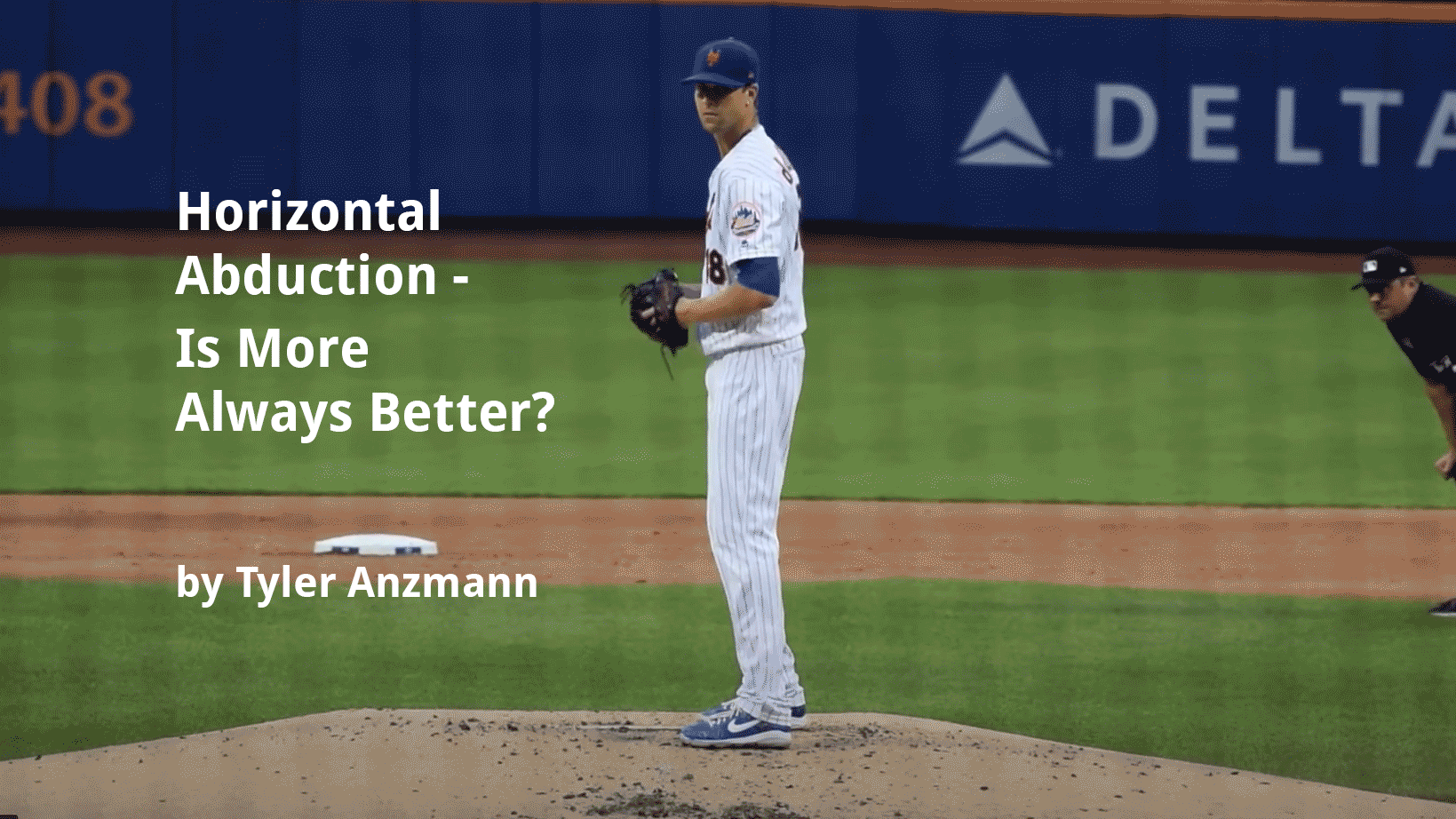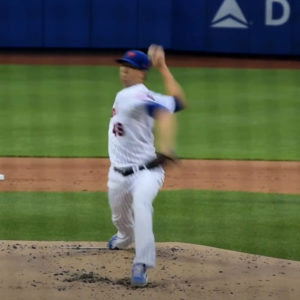All pitchers have heard certain mechanical cues and common phrases used by teammates and coaches everywhere. Along with hip/shoulder separation, “scap loading” is one of those phrases. Scap loading is a phrase originally coined by Paul Nyman and refers to the retraction of the shoulder blade (scap) prior to and at cocking. Basically, when the forearm is perpendicular to the ground, when viewed from the front, the hand should be behind the head or farther behind the body.
While more horizontal abduction may be better in a general sense, on an individual basis it doesn’t always play out this way.
Horizontal Abduction
Horizontal abduction is the movement of the arms away from the midline of the body in the transverse plane. Think about the lowering of the pec fly.
Greater horizontal abduction at foot strike has been associated with higher ball velocity (Stodden et al., 2005). This makes sense since higher horizontal adduction angular velocity is associated with higher ball velocity (Takahashi). The pec is one of the main accelerators of the arm and horizontal abduction places a pre-stretch on the pec, enhancing the horizontal adduction that follows.
A pre-stretch that immediately precedes a contraction leads to a more powerful shortening action. This is the basic principle of the stretch shortening cycle. While a pre-stretch helps to maximize the performance or output of the pec, the optimal amount of stretch will vary from athlete to athlete.
Horizontal abduction that maximizes horizontal adduction velocity is what we’re after, not maximal range of motion (ROM) for its own sake. The key here is identifying what ROM that is for each athlete. The purpose of the stretch is to get a more powerful and rapid shortening to follow. If the stretch is too great this does not happen, either due to the time delay between the movement couple, the descending force curve (see length tension section), or both.
The power of horizontal adduction isn’t only important in and of itself, but it helps with layback and setting up the rest of the arm action. Horizontal adduction helps lay the forearm back by increasing the inertial mass of the ball/hand. This means layback isn’t a volitional act, but the result of efficient movements leading to that point (like the lead leg block). And, getting horizontal abduction right helps set up the rest of the delivery.
The Argument for More Horizontal Abduction
The goal of the arm action is to apply the largest possible impulse to the baseball. Impulse is simply force multiplied by the duration of its application. This means that the greater ROM the baseball goes through, all other things being equal, the larger the impulse. In this case the ROM we’re discussing is the path from the time the forearm is perpendicular with the ground (cocking) to ball release. If we viewed this from above a pitcher this would look like a half ellipsis. The main goal would be to have the longest ellipsis possible, and one of the factors in the distance of that path is horizontal abduction.
However, this line of thinking leaves out a few important pieces:
- How much force is produced-it assumes force is constant in all conditions
- The velocity of the arm action
- The factors affecting said force and velocity.
Here’s where some of the individual differences begin to manifest themselves.
Individual Differences
As with all pieces of the pitching delivery, the amount of horizontal abduction will vary from athlete to athlete for a variety of reasons. Think about this in terms of basketball. Athletes who tend to be better two-foot jumpers tend to use a slower run up (if at all), go through greater ranges of motion, and they spend more time on the ground to produce high force outputs. Their counterparts who tend to be better one-foot jumpers do well with a faster run-up, significantly reduced range of motion (more stiffness), and get off the ground very quickly. If the assumption is made that more ROM is better, then you’d push for the one-leg jumper to sit deeper and spend more time on the ground. However, this would likely lead to a worse jump due to the poor utilization of elastic energy, lower takeoff velocity, and that athlete’s unique abilities. If you tried to push one of these athletes into the other method of jumping they would not do very well, due to a variety of physiological and neurological factors. The same is true with pitching mechanics. While there are obviously adjustments that need to be made by throwers, there is a certain bandwidth they must remain in to achieve their highest velocity.
Mobility and length tension relationships tend to work hand in hand. Where flexibility is passive ROM, mobility is active ROM that can be controlled. This implies a certain level of strength throughout this ROM, which flexibility does not.
Every muscle has an optimal length range to create tension or force, and tension is maximized when the number of cross bridges are optimized. If a muscle is too short or too long, the number of cross bridges that can form is not maximized. Meaning, there’s a Goldilocks effect here with the length of a muscle fiber. Additionally, the passive piece of this equation is the elastic elements; the tendons, the fascia, and the aponeuroses. These components can create more passive force the more they are stretched.
If we think about this in terms of horizontal abduction this means that if a pitcher’s pec has a relatively shorter optimal length, then increasing horizontal abduction in the delivery past this point will not be beneficial to increasing velocity and may increase injury risk. The length tension relationship can be altered through training (see these articles 1, 2) but that’s beyond the scope of this article.
Basically, if you don’t respect individual athletes’ length tension relationships, even if you are able to increase horizontal abduction, you’re not positively impacting pitching performance.
Health and Injury Risk
The other piece to consider here is the impact on the health of the athlete. If an athlete can’t remain healthy enough to train and compete consistently, then the mechanical change was ill-advised. As with all training, the first job of a throwing program/coach is to do no harm. Increasing horizontal abduction can be particularly dubious in this regard because if it is done improperly, shoulder health may be negatively impacted.
The shoulder is a complex combination of joints with relatively low stability and extreme range of motion. This means that if a mechanical change results in less stability, health can become a concern.
The scapular and rotator cuff muscles work together to provide stability to the glenohumeral joint (humeral head and glenoid fossa). As the arm moves in space, the humeral head must stay centered on the glenoid fossa or tissues around the joint become at risk for injury. To keep this congruent relationship, the scapula must be able to move in such a way that the glenoid fossa is positioned to allow the rotator cuff to do its job. In terms of increasing horizontal abduction, this means that care must be given to scapular movement and rotator cuff strength. If horizontal abduction is increased carelessly through aggressive stretching or poorly designed drill work, the humeral head may translate forward and stretch some of the tissues in the anterior part of the shoulder capsule. This may take them out of their most effective length range and make it more difficult for them to stabilize the shoulder.
Practical Application
For some athletes it is worthwhile to explore enhancing mobility and greater horizontal abduction in the delivery in conjunction with rotator cuff strength and reflexive reactivity.
Soft Tissue Work and Mobility
Hypertonic (too much tension) and/or shortened pecs and pec minor can be problematic for horizontal abduction. While many soft tissue methods may not be the magic pill that some people once believed them to be, they do still provide some meaningful benefits when used correctly. Pressure, massage, and vibration can help relax hypertonic muscles and reduce measures of soreness (Imtiyaz et al., 2014). Additionally, self-myofascial release (SMR) can increase ROM acutely (Beardsley and Skarabot, 2015).
Long term changes aren’t necessarily being made to the tissue through the SMR alone, but these movements create a window of opportunity that can be used when they are paired with mobility drills, isometric holds, and other movements through a full/exploring new ROM.
One pairing that we like is a barbell pec smash followed by a prone T or a prone horizontal abduction iso hold.
Thank you to Kelly Starrett for the pec smash idea as well as Ben Brewster for improving upon it by adding weight when you don’t have a partner.
Pairings like these can make changes over the long-term but are far from quick fixes. Be patient and don’t force the ROM.
Training Through A Full ROM
One of the most important elements we’ve discussed when improving horizontal abduction is strength through the end ROM. This means training these end ranges in the gym.
Once you’ve mastered push-ups, adding ROM can be helpful.
Ensuring that dumbbell bench presses are done through a full ROM. Get your floor presses for pitchers out of here!
Eccentric Exercise and Changes to the Length Tension Relationship
As I’ve discussed before, eccentric movements can help shift the optimal length of muscles to longer lengths. This allows for a greater contribution from the elastic elements due to the greater stretch available to them. These are more advanced methods and should be performed by intermediate and advanced trainees once they’ve mastered movement quality and built a base of strength (a specific range isn’t necessary here, but if you can’t do 10 push-ups or squat your bodyweight, you’re not there yet).
Constraint Drills
In order to make meaningful changes to a throwing pattern, constraints are necessary. Verbal cues during a bullpen are not enough. These are also the final piece to the puzzle. If strength and mobility have not been addressed, or aren’t being addressed simultaneously, you’re wasting your time.
Here are two drills I like for improving HA/feeling the pec and torso driving arm action:
Allow the torso to begin the rotation and set your pec up to pull the arm through.
Also, note that many drills can help with improving HA simply by using a flexed elbow and supinated hand position prior to beginning the movement.
Conclusion
Horizontal abduction is an important piece to high velocity arm action and pitching mechanics as a whole. However, more of it is not better for all athletes. The ideal amount of horizontal abduction is that which leads to the highest velocity of horizontal adduction and allows the glenohumeral joint to remain stable and healthy over the long term.
Interested in training with us in-person or remotely? Contact us and let’s set up a time to discuss your needs.


